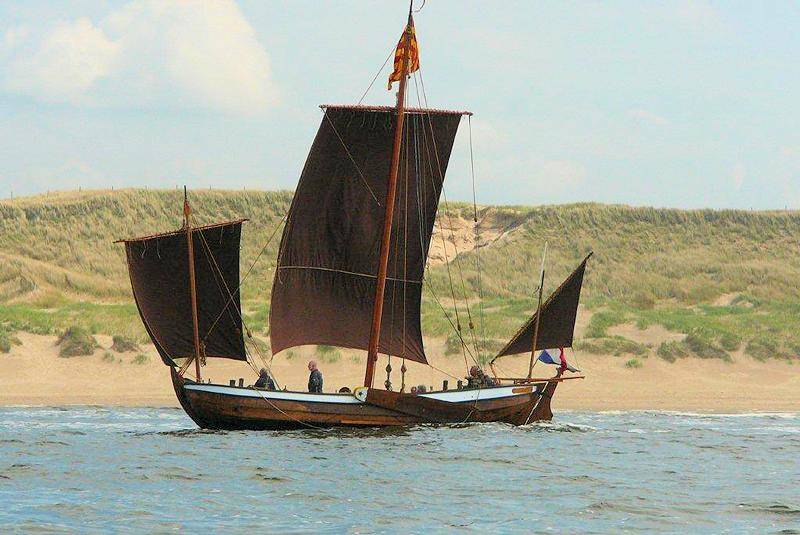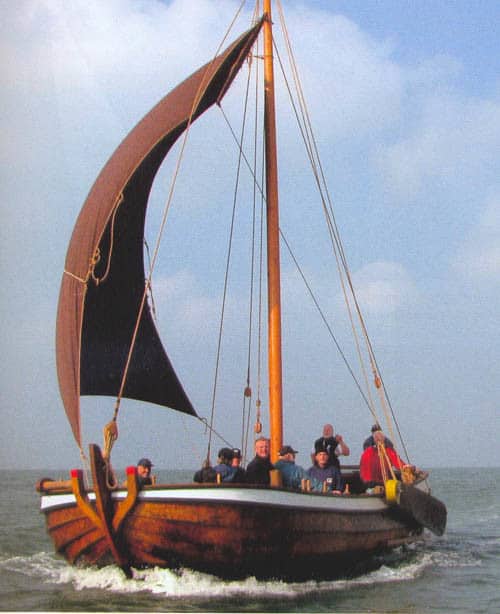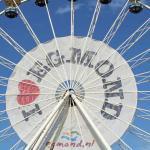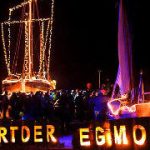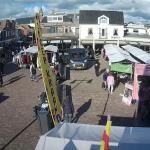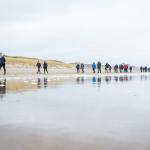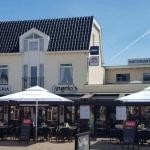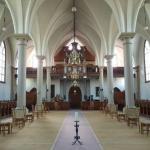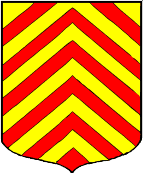The Pinck rebuilt
Next to the boathouse of the KNRM, a little south of the main beach exit, under a shelter is the half-open building and storage place of the Pinck.This is a flat-bottomed (fishing) vessel as it has been used for centuries in Egmond to take to the sea directly from the beach. It is a reconstruction from the period around 1670 and the forerunner of the later bomschuit. Years took master builder Jan Sander and his volunteers to craft this authentic sailing vessel from the wood of a pile of logs. In the process, things did not always go their way. Consequently, they grew to admire the barge builders of the past, who had to do everything with simple tools.
Reconstruction Egmonder Pinck
The measurements were given in a handbook by Nicolaes Witsen in Amsterdam feet and inches. (1 A’dam foot is 11 A’dam inches = 28.31 cm.) Converted, the pinck was 35 feet over the stem by 12 feet inside the hull, 9.91 meters long by 3.40 meters wide. To the last measure, add the thickness of the skin strakes. The pinck was built according to these dimensions, rigged with two masts and equipped with yardsails. A piece of history has come back to life.
In the spring of 2007, the Pinck was christened by a woman and named “Çlaes Teunisz. It was consecrated by the abbot of the abbey. In good weather, she will be launched for a sailing trip. Under the mast is an old “lucky double.
Visit the construction site
All Wednesdays & Saturdays from 8:00 a.m. to 3:30 p.m. You will find the men here doing the job or maintenance. And there is usually someone there to show you around. They also made a dinghy and Miffy’s boat that is at the beach exit. The visit is free, but they appreciate a small contribution, as the Pinck does cost a bit more than in the 17th century. You can also buy a booklet there about fishing and the Pinck and one about the Egmond dialect.
A guided tour costs € 1,- p.p. with a minimum of € 25,-. Please call Jan Sander, 072 506 4498, Ed Groen 06 53412759. See also www.pinck.nl
Open House
From late June to early September, it’s open house every Friday night from 7 p.m. to 9:30 p.m. just like the lifeboat’s neighbors. On special days and Lifeboat Day, there is also a lot going on around the Pinck.
History of the pinck
(courtesy of Jan Sander)
 The coastal region from Hoek van Holland to Den Helder was called “the Silde. Since there were no harbors, people sailed with small vessels that had flat bottoms. In Egmond aan Zee, for example, people developed a small ship called a “pinck” around 1400. A flat-bottomed vessel about 5.50 to 6 meters long and about 2.5 meters wide. The little ship with a pleat fore and aft, was built overnaad with a completely flat bottom, so it could be transported to the beach on rollers from the barge shed. Once there, it was further equipped with nets, fishing lines and whatever else was needed for fishing. Then the pinck was brought to the low-water mark. With a small rowboat an anchor was brought out and with the rising tide the pinck came afloat. Thus fishing trip after fishing trip was done, always taking into account the tide.
The coastal region from Hoek van Holland to Den Helder was called “the Silde. Since there were no harbors, people sailed with small vessels that had flat bottoms. In Egmond aan Zee, for example, people developed a small ship called a “pinck” around 1400. A flat-bottomed vessel about 5.50 to 6 meters long and about 2.5 meters wide. The little ship with a pleat fore and aft, was built overnaad with a completely flat bottom, so it could be transported to the beach on rollers from the barge shed. Once there, it was further equipped with nets, fishing lines and whatever else was needed for fishing. Then the pinck was brought to the low-water mark. With a small rowboat an anchor was brought out and with the rising tide the pinck came afloat. Thus fishing trip after fishing trip was done, always taking into account the tide.In bad weather, these pincks could be pulled up against the foot of the dune or even back into the village if necessary. The first pincks were smaller than the replicated ship.
The Pinck suffered greatly
The Pinck was built fairly round and overnaad with a heavy plane and while landing resistant to bumping on the sandbanks and beach. This landing was actually a controlled form of beaching, even in bad weather, and placed high demands on the structure. Because of its construction method, the pinck was able to withstand this well. Despite this, pincks at a beach operation lasted only about 8 years on average. Then a new hull was made. Mast, swords, rudder, rigging and further inventory were then transferred to the new vessel.
Other fishing villages
Many other coastal towns adopted the ship type, the best known being Scheveningen and Katwijk. Other places were Ter Heide, Noordwijk, Zandvoort, Wijk aan Zee, Bergen and Schoorl, Petten, Callantsoog and Huisduinen. After 1530 Bergen and Schoorl were no longer mentioned, apparently fishing had ended there.
Fishing from Saint Martin to Pentecost
Fishermen were hired from St. Martin to Pentecost because the main season for fishermen was during the winter months from November to May. From November to January, angling for haddock and cod was practiced, then until May, standing rigging or seining for plaice and other flatfish and angling for haddock and whiting. Summer was a slack time. The larger pincks were used for merchant shipping at that time. In July 1440 an Egmonder Pinck laden with wool lay in the harbor of Happisburgh, 20 kilometers north of Great Yarmouth.See also www.pinck.nl
The success of the Pinck
Around the year 1514 there were an estimated 180 fishing vessels operating on “de Zijde” including about 105 pincks. According to tax records from that time, Egmond then owned more than a quarter of this total. About 26 pincks and about 20 other vessels (slabberts or barges). The catches, consisting of round and flat fish, were salted and dried for preservation and mostly sold on the market in Antwerp, where many foreign traders bought dried plaice from the “Zijdse” villages.
Share Fisherman
No dimensions are known of the slabbert and barge, but they were small vessels, owned by the skipper with two to three crew. Even then there was an increase in scale, but many boat owners could not afford a larger vessel (a pinck).
Thus, they were forced to give up fishing or join a pinck as associates as so-called share fishermen. The share fisherman brought his own fishing gear on board and received his share of the besomming. Bringing one’s own fishing gear has worn out over the years. However, until the end of Egmond’s brace fishing for bomb barges, in the 1990s, it was still common here for fishermen to bring a number of barges with corner lace of their own.
Sailing “by share” (for part of the besomming) has remained in use to this day.



